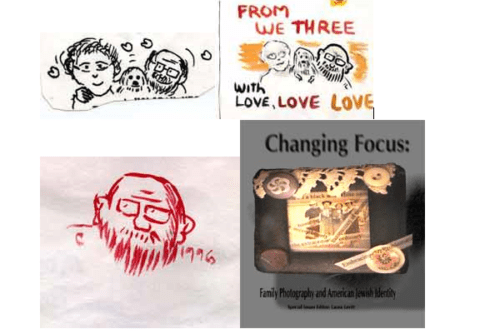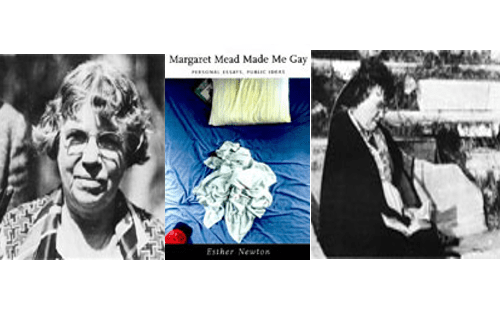Novak’s work is most productively read in the context of the work of artists who in the last two decades have made family pictures the explicit subject of their work. She was included in the 1991 Museum of Modern Art Exhibition “The Pleasures and Terrors of Domestic Comfort,” curated by Peter Galassi, the first major museum exhibit to document this domestic preoccupation in contemporary photography. This show was quickly followed by other large and small exhibits throughout the 1990’s, for example, “Flesh and Blood: Photographers’ Images of Their Own Families” organized by the Picture Project and the San Francisco-based Friends of Photography in 1992, Deborah Willis’s “Imagining Families: Images and Voices” at the Smithsonian Institution in 1994, my own “The Familial Gaze” at the Hood Museum of Art at Dartmouth College in 1996 and Novak’s revolving World Wide Web exhibit “Collected Visions.”
Two basic approaches have shaped this photographic work of exploration and contestation, and both trends are clearly visible in these exhibitions. A first group of artists seemingly record family members and family relationships in real time preserving, even in their posed portraits, the documentary aura of family snapshots. And yet, at the same time, they comment on the conventions of family photography. This trend is exemplified by photographers such as Sally Mann, Larry Sultan, Nan Goldin, Tina Barney, Philip-Lorca Dicorcia, Vance Gellert, Nicholas Nixon, Judith Black, Doug DuBois and Dick Blau. More complex techniques of projection, collage, super-imposition and installation characterize a second trend in contemporary familial self-representation that includes artists like Lorie Novak, Lorna Simpson, Pat Ward Williams, Clarissa Sligh, Art Spiegelman, Albert Chong, Tatana Kellner, Darrel Ellis, and Carrie Mae Weems. Although the artists in both groups comment on the conventions of family photography, they raise a number of distinct questions.
The images exemplifying the first trend offer familial subjects a mirror in which to see themselves reflected in a life narrative that shapes personal and familial memory. Their photographs are close to the snapshots that any of us might have in our own albums. Yet they are also markedly different, and not just in technical quality. Mostly, they tend to make visible, in various ways, what most family snapshots wish to deny in their unselfconsciousness – the ways in which the presence of the camera shapes family relationships into performances, and, conversely, the ways in which the images reveal the staged and performative aspects of all family relationships. In the family we play our roles – of mother, father, sister, brother, spouse, parent or child – for each other, as well as for the familial gaze we have internalized. The looks we exchange fix us in our roles; and it is as such that we engage each other and the viewers. In the photographic work of these contemporary artists, we can read this process of familial construction and subject-formation through the exchanges of looking.These images stage exposure as well, defining the blurred line between public and private in family life and self-representation. For example, as mothers, Judith Black or Sally Mann – two very different artists – possess privileged access to the most intimate moments in their children’s lives. As photographers they have chosen to make these private moments public, and in doing so they raise a number of questions about the maternal photographic gaze: What is the power relationship between photographer and subject if they are mother and child? In what ways can we interpret the responses of Mann’s or Black’s subjects to her gaze? And what effects have these images had upon their children’s development, on the relationships within their families? Is the camera an instrument of fixing, of appropriation and intrusion? Or are their subjects willing participants in the endeavor? How, as viewers outside of the family, do we feel addressed? How implicated are we in the images? What enables us to identify and project ourselves into them? And what keeps us out and separate? What story do these images tell and what instruments do we use to read it: do we necessarily read them in relation or in contrast to our own family stories? And – most importantly, perhaps – what does the photographer reveal about herself as she takes photographs of other family members? How is she reflected in the images of her children, images she has herself taken, developed and chosen to display? The family pictures of these artists reveal the permeability between the genres of family picture and self-portrait. They are oblique forms of self-portraiture, exploring the affiliations and mutual perceptions that structure subjectivity. This type of familial photographic representation has offered women artists in particular at once a form of work that is compatible with domesticity and a vehicle for exploring the power relations that have shaped women’s lives within the family.
The second group of artists embeds archival images in new layered and composite texts that recontextualize these images, or they combine images with other visual and sometimes verbal texts, thus presenting them in new ways.In breaking the photograph’s unforgiving frame, they reveal absence as well as presence, fantasy and unreality as well as reality, gaps as well as plenitude. Thus they can undercut and undermine the documentary illusion of photography by producing staged, constructed images, photographs of photographs. These artists reveal, as well, the layering of memory, the simultaneity of different generations, and the intricate interconnection of public memory with personal and familial remembrance. Layered constructions lend themselves particularly well to the aesthetics of cultural retrieval important to the project of women artists and artists who are member of exiled or minority groups, such as Jewish artists. They offer a means of self-representation that is complexly relational and multi-layered, revealing the construction of individual subjectivity diachronically over time and generation, and synchronically across space and cultural borders.

Whichever of these two trends they might most closely align themselves with, the photographers who photograph their family lives and their domestic spaces have made not just the family but family pictures themselves – the family’s technologies of representation – the objects of scrutiny and representation. More than other representational media, photography has the effect of naturalizing cultural practices and of disguising their stereotyped and coded characteristics. As photography immobilizes the flow of family life into a series of snapshots, it perpetuates familial myths while seeming merely to record actual moments in family history. Yet these artists go beyond the conventional and opaque surfaces of family photographs. They search for techniques by which they can expose the complicated and layered, contradictory and incomprehensible stories of familial relation – the passions and rivalries, the tensions and problems – that have, for the most part, remained outside of family albums. These artists thus attempt to use the very instruments of ideology, the camera, the album and the familial gaze, as modes of questioning, resistance, and contestation. They show that by disrupting the documentary authority and the evidentiary status of the photograph, they can use photography as a powerful weapon of social and attitudinal change. They can do so by challenging our expectations, and by teaching us to see differently. They thus interrogate, quite self-consciously, aspects of familial representation that tend to remain invisible in conventional photos – the role of ethnicity (Jewishness, for example), gender, sexuality, race, age and power in the construction of familiality, identity and subjectivity. At the same time, these artists use family pictures as instruments of self-knowledge and self-representation, as a way to examine their own roles within the family and the role of familiality in their own self-conception.


